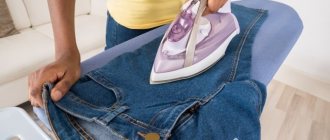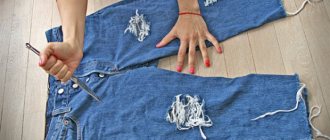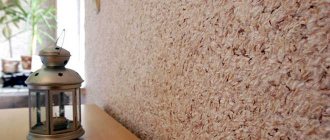From the history of jeans
Fashion historians have established that Italian sailors were the first to wear pants made of canvas. This material was widely in demand, was cheap, and products made from it were wear-resistant. Afterwards, such trousers received the name “Jenes”. It is believed that this word comes from the name of the city of Genoa, located in Italy and famous for its canvas.
At the end of the 18th century, a book with samples of textile products was published in France, which showed descriptions of pants that looked like jeans.
In the mid-19th century, the Belgian Leiba Strauss arrived in America, whom the sailors immediately dubbed Levi Strauss (in English this name sounds like Levi Strauss). The son of a poor tailor, he had very little property with him, including a solid roll of canvas material, from which, upon arriving on American soil, he began to sew tents according to the orders of gold miners in order to somehow feed himself.
Once a gold miner he knew complained to Strauss that if he had good pants, he could do without a tent, just sleeping under a tree. The enterprising Strauss recalled the tailoring skills passed on to him by his father, and quickly enough sewed good-quality pants from canvas, which he immediately sold to a gold miner for a dollar or less.
The product was a success, so soon Strauss had new customers.
Jeans: simplicity, comfort and functionality
In the first half of the 50s of the nineteenth century, a lucky tailor founded his own workshop in the city of San Francisco, in which he began to sew pants for gold miners and other workers. Strauss personally visited the villages of gold miners, finding out the desires of potential clients and improving his own products. The workers were pleased with the way Strauss carried out orders.
Soon the trousers were equipped with belt loops, as well as spacious front and back pockets. For good reliability, Strauss made all seams double. A couple of years later, the seam joints on the pockets were reinforced with iron rivets. Having patented a new type of workwear in the first half of the 70s of the 19th century, Strauss began to choose more material that was suitable for his own products. The choice fell on thick cotton fabric with a diagonal weave. This is how modern jeans came into being.
When the number of people seeking to get rich in the gold mines decreased, jeans went into the general population, becoming everyday clothing for very ordinary people. Interestingly, during the Second World War, comfortable and durable jeans began to be used in the United States Army. They were worn by those who specifically took part in hostilities.
Fighting toughness
Many people know that jeans do not need to be washed after every wear. The material from which they are made is extremely durable and durable, which is why they are very popular in different parts of the world. Also, wear resistance allows the product to be wet cleaned only after the fourth or fifth wear in a row. In practical conditions, it can be cleaned less often, using different methods. This piece of clothing is in most cases made from thick cotton material, to which various artificial fibers are added. The ratio between the volume of cotton base and additives affects how much the item settles and how stiff it is after wet cleaning. The relationship is directly proportional: a decent amount of cotton fibers guarantees greater rigidity of the dried trousers and a very high tendency of the product to shrink.
Specifically, after wet cleaning, you can understand that the trousers have become stiff.
Iron and starch
Corn or potato starch and iron are used as a softening agent.
How to proceed:
- Place the jeans right side out on the ironing board.
- Prepare the solution: 1 tbsp. l. starch per 2 liters of water. You can buy a ready-made product in the store.
- First, apply the solution to the fabric using a spray bottle, then go over the treated areas with an iron.
This method actually softens the fabric, despite the fact that it uses starch, which is usually needed to stiffen knitwear and dresses.
Alternative cleaning methods
Opponents of machine washing jeans complain about the loss of shape, color and the acquisition of an unpleasant stiffness. Using other methods of care will help to avoid situations of this kind. Remove small stains using a kitchen sponge soaked in water. When taking a shower, hang the product in the bathroom - this will help them steam off. The “main” wash with a similar approach can be carried out a couple of times a year. Do not wash the product in a machine - you can get rid of dirt in the bathroom without much effort. The water should be cool and the cleaning agent should be non-aggressive. Use white vinegar to preserve the dark color of the product - just add a minimal amount of the substance to the water.
Before you start washing, first of all pay attention to the label and follow the instructions exactly. It is better to turn your trousers inside out beforehand. The detergent composition must be soft and non-aggressive. When cleaning in an automatic machine, only cool or cold water is suitable. Hand washing in the bathroom is considered preferable. Sometimes you just need dry cleaning. This type of anti-pollution option is suitable for dark-colored products. Do not soak this item of clothing and do not use hot water for washing (temperature should not exceed 40 degrees). After wet cleaning there is no need to wring out the product.
Mitigation methods
The fabric itself is not solid. It acquires this property after painting and impregnation with a fixative.
Regular wear - 3-4 times a week - will help make the fabric softer. It is advisable to wear them during outdoor activities, where the person is expected to run, jump and make a lot of movements. If this is not possible, they are worn at home for several hours. These are only the first steps, which are not enough to soften the jeans. Therefore, people use special methods of washing, mechanical stress or using food products available in each apartment. Making jeans soft at home is easy and inexpensive.
Washing and drying
It is recommended to do this on the day of purchase to reduce discomfort while wearing in the future. Before the procedure, the item is turned inside out. An increased amount of powder is added to the washing machine or mixed with a detergent that makes the fabric soft. The temperature in the process should not exceed 70 degrees, which will damage the fabric fibers, as will high spin power. The next wash is carried out without powder, but with 2 tablespoons of soda and fabric softener. The product will not spoil the color and fabric. The procedure is repeated 3-4 times. It is advisable to dry your jeans naturally. If you have a dryer in the house, you should not set the temperature to high, as it causes the fabric to harden. The same rule applies to ironing the product.
Using hair products
Instead of regular washing powder or liquid, use shampoo. Any one is suitable for this, but it is advisable to take a child’s one, which contains fewer parabens and other harmful substances. It is designed to wash and soften hair and has a similar effect on jeans. Hair balm or conditioner is added every time you wash.
Use of acetic acid and table salt
These two ingredients are mixed with water and the jeans are soaked with it before the first and subsequent washes. This procedure not only helps to soften the fabric, but also preserves the color, which is no less important. To soften the fabric, you must perform the following steps:
For the first soaking, sodium bicarbonate is used.
- Add salt to warm water.
- Place the item for 1-2 hours.
- Take it out and squeeze it out.
- Dissolve 10 tbsp in a glass of vinegar. l. water.
- Rinse or leave for 2 hours.
- Dry and wash in washing machine.
Return to contents
Using an iron
The essence of this method is not simple ironing. The softening effect is achieved by spraying a solution with the addition of starch onto the fabric. This will require 1 tablespoon of starch and 2 liters of liquid. They are thoroughly mixed and added to the spray bottle. The mixture is carefully treated with the jeans and ironed with a warm iron. After this procedure, the product ensures comfortable wearing.
Sandpaper
To do this, use fine-grain sandpaper. Before processing, jeans are turned inside out. Rub the product with a small piece, the movements should be clear - only back and forth. In the process, pellets appear and hard fibers are knocked out of the fabric. After sanding, the jeans are shaken and turned inside out. If sandpaper is not at hand, a razor, stone, pumice, or blade can replace it. You cannot go through the same place twice.
Sanding thin jeans is prohibited.
Recommendations for drying and ironing plus a few life hacks
To keep the fabric comfortable and soft, and the item comfortable, follow these simple rules. Dry the item by laying it flat on a surface or hanging it on a rope by the bottom of your pants. It is not advisable to use a dryer. When drying this way, try to set the temperature to a minimum. After drying the product, do not turn it inside out immediately, iron it as is. It is better to iron the item slightly wet, with the iron slightly heated. Some irons have a separate mode, which is great for ironing denim. Washing jeans can be completely replaced by a similar original cleaning method, like freezing. The item must be left in the freezer for several hours - this will help get rid of dirt.
To stretch your trousers, wet the part at the top near the waistband, fasten the zipper and place more different items in the middle until the girth reaches the required value. If the problem is the opposite, you can make the size smaller by washing it in a washing machine and drying it in a dryer or bathing the item in a hot bath. The item should be placed in an automatic washing machine and washed in cold water at a lower speed without adding laundry detergent or similar products. Afterwards, you need to wring out the item of clothing and dry it in the dryer. The second way is to put on jeans and climb into a hot bath in them, staying there until the water cools down. Using the described recipes will help preserve the item for a long time and make the wearing process good and comfortable.
Traditional hard jeans have five pockets, they are not usually tucked, and can be worn either on the hips or on the belt. To find out the quality of jeans, look at the cuts; they must be stitched evenly and must be closed. This applies to both step and internal seams.
It's very easy to make good traditional jeans feel super soft. Be sure to wash them with a very decent amount of laundry detergent, approximately several times more than usual. Select the longest washing mode; as soon as the washing is completed, do not remove the jeans from the machine, but set the machine to the rinse mode.
After which the item must be soaked in a basin with warm water and the addition of 2 tablespoons of soda. There is no need to worry about the effect of soda on denim; it will not cause any damage. A few hours after soaking, we begin washing again, but with the usual portion of laundry detergent. Once the wash is complete, the jeans should be rinsed further by adding a large dose of softening conditioner and baking soda. Then they can be dried, but not completely, but until slightly wet.
Now all that remains is to iron them through gauze. The product may remain slightly damp around the seams, but this can be easily corrected by hanging them in the bathroom to dry. It is better to put on new jeans while lying down for the first time, since they are not yet worn out. The feeling of comfort will not come immediately, so when you put on jeans, try to make several movements: squat, bend your knees, bend over a couple of times. Even the toughest denim fabric wears out a little in 1 day, and after seven days the jeans will become completely “obedient” and fit perfectly.
For today's person, buying jeans has become a ritual, thanks to which each of us has some unusual tastes, for example, waist height. Don't buy jeans that fit loosely. Taking into account that the fabric will stretch a little over a certain time, they will become simply too large, unsightly folds will appear in certain places, and gradually the jeans will take on an “unfolded look.”
How to care for your jeans so they last you a long time
Wash
For some it is a known fact, for others it is a real revelation that jeans do not have to be washed every time they are worn.
As you know, denim is very durable and durable, and it is these qualities that have made it so popular all over the world. And it is these qualities that allow you to wash your jeans only after the fourth or fifth time you wear them. In fact, jeans can be washed even less frequently, using other cleaning methods, in particular freezing, which we will discuss separately below. If you are an ardent opponent of washing jeans, you don’t like the fact that after washing they lose their shape and fade, and the fabric becomes tougher, we offer you an alternative strategy for caring for jeans.
You can remove small stains from jeans with a damp kitchen sponge and hang the jeans next to them every day when you take a shower so that they can be lightly steamed. You can do a “general wash” once every six months. At the same time, wash jeans not in a washing machine, but in the bath. We are sure that this advice may shock a good portion of readers, but many true jeans connoisseurs use it, varying the maximum wear time for themselves.
When washing jeans in the bath, use room temperature water and a mild detergent. If your jeans are dark, you can add a little white vinegar to protect them from fading.
General tips for washing jeans:
- Read the label carefully before washing.
- Be sure to turn your jeans inside out before washing.
- Use a mild detergent.
- Wash in cold water or at least room temperature water on a gentle cycle if machine washing. It is best to wash your jeans by hand in the bathtub as described above.
- In some cases, dry cleaning is recommended (for example, if the jeans are dark).
- Remember that jeans cannot be soaked and should be washed at a temperature no higher than 30–40 °C.
- After washing, do not wring out your jeans.
- Don't wash your jeans immediately after wearing them. Jeans can be washed after the fourth or fifth wear or even less often.
Drying
- It is best to dry in a horizontal position. You can also dry your jeans by hanging them upside down.
- If you have to dry your jeans in the dryer, use the lowest heat setting. In general, it is highly not recommended to dry jeans in dryers.
Ironing
- After drying, do not turn the jeans inside out; you can iron them from the inside out.
- Remove slightly damp jeans and begin ironing at low temperature. You can use the steam mode at low temperature. Some irons have a special mode for ironing jeans.
Lifehacks
Freezing
There are many denim hacks out there, some of which may shock you, but they work! For example, the CEO of the blog Apparel Therapy talks in a video about how you can replace washing jeans. Everyone knows that the less you wash your jeans, the better they look, but very few people know that washing can be replaced by freezing a pair of jeans in the freezer.
Stretching
Jeans usually serve the owner for more than one year, and the owner’s weight category may increase slightly. The problem of size mismatch is solved by stretching the jeans. To do this, wet the belt and fill the volume with various objects, gradually adding new ones.
Downsizing
If you have the opposite problem and need to shrink your jeans, there are two ways to do this: using a washer and dryer or using a hot bath.
- Throw the jeans into the washing machine, turn on a low speed, the water should be cold. Do not use laundry detergent or other laundry detergents. Then spin and dry. If you have a dryer, it is better to do this in it.
- Fill the bathtub with hot water. Put on your jeans and immerse yourself in the bath. Lie in it until the water cools down. Attention! Do this carefully, do not overdo the water temperature!
Search for the desired model that is no longer in production
If you are conservative and buy the same model year after year, and it suddenly goes out of production, don't worry, you can buy it again and again. Look at the inside information label. If it hasn’t been erased, then there is data about your jeans model and you can google them on the Internet and buy them again.
Here are a few life hacks that help solve various types of problems with lightning.
Lightning stuck
If the zipper is stuck, a graphite pencil can be used to save the situation by running it along the teeth of the zipper. If a graphite pencil does not help, we move on to “lubricants”: a drop of oil, chapstick, soap.
The zipper does not fasten all the way and is not fixed at the top
A common problem that sometimes leads to awkward situations. If you are not going to completely replace the zipper, then a key ring or key fob can be a temporary solution. The ring is attached to the zipper pull and then hooked onto the top button. Voila, your fly no longer comes undone when it shouldn’t.
Lightning Damage
If the zipper does not fasten due to missing teeth, then it needs to be replaced (if the tooth is missing in the upper third of the zipper) or dispensed with without replacement (if the tooth is missing in the lower third of the zipper). Fasten the slider so that it is above the damage. Then thread the needle and make a few stitches just above the damaged area.
Another option is to make a button closure by carefully removing the damaged zipper.
The tongue came off
The tab can come off at the most inopportune moment, and fastening a zipper without a tab is not an easy task. As a temporary solution, you can suggest attaching a paper clip or a key ring instead of the tongue.
We hope these tips help extend the life of your favorite pair of jeans.
Share in the comments which method works best for you and tell us about your ways to extend the life of your favorite clothes.
Setting the color of new denim trousers
Before loosening your jeans at home, you need to worry about fixing their color, otherwise you run the risk of damaging them. Before washing your trousers for the first time, you need to soak them for some time in a slightly salted solution of water with the addition of vinegar.
Important! Do not forget that not all jeans that can currently be purchased on the market or in a brand store can be washed in an automatic machine. And products decorated with appliqués or rhinestones are generally recommended to be washed only by hand.
How to make jeans very soft?
Now let's talk in detail about how to make hard jeans soft. To achieve the result, you must act according to the instructions given:
Important! For the first time after completing the steps, it is better to put on your pants while lying down, due to the fact that they have not yet been worn out. Most likely, at first you will experience discomfort, but there is nothing terrible about this - you need to walk a little in them, squat, bend your knees ten times, and everything will return to normal. For them to become completely obedient, you will have to wait about a week.
How often should jeans be washed?
As we already know, jeans are made from the most durable and at the same time durable material, which is why they are so popular. They have excellent wear resistance, so it is recommended to wash them after the fourth or fifth wear, requiring daily use. In practical conditions, they are cleaned very rarely.
Sometimes they become hard again after the tenth or even twentieth wash, and this problem, as a rule, can certainly be solved. You can try to loosen them by simply stretching and shaking the product.
Important! If your jeans seem overly starched, you can get rid of this result by steaming or ironing.
How to iron and dry jeans correctly?
You already know how to make jeans soft at home. But you also need to figure out how to preserve this softness for a long time:
- They need to be dried only on horizontal surfaces or by hanging them by the bottom of the legs on a rope.
- It is better to avoid using a specialized floor dryer.
- Immediately after they become dry, do not rush to turn them inside out, since ironing should take place on the reverse side. It's great if they are slightly damp at this point.
Important! To completely remove the dirt from them, you can put them in the freezer for a couple of hours. As a rule, this specific cleaning method can be used to replace a typical wash.
Before the first wash, it is best to soak your jeans in salted water and vinegar. This will help fix the dye and preserve the color of the jeans for a long time. Wash your jeans in the washing machine, approximately doubling the amount of laundry detergent. By the way, it is better not to set the temperature too high, let alone high spin speeds - this can damage the fabric. Then rinse them thoroughly. Washing will remove some of the tannins that impregnate the fabric. However, not all jeans can be machine washed. If they have rhinestones, appliqués, or other decorations, it is better to wash the jeans by hand. In all circumstances, add more powder than would normally be the case. By the way, when washing by hand, first dissolve the powder in the water mass, and only then put the jeans there.
An additional solution to the problem of how to make jeans soft is to wash them with the addition of baking soda. If you wash your jeans in a washing machine, you need to add soda at the rate of one tablespoon per 5 liters of water. On average, 10 liters of water are poured into the drum of a washing machine. Under any circumstances, these indicators can be found in the instructions for the washing machine. You don’t have to wash your jeans a second time, but simply soak them in baking soda and leave them for a couple of hours. After that, the jeans need to be rinsed well enough to remove from the fabric the remains of the powder, soda and substances that soaked the fabric during the washing process.
To get soft and comfortable jeans, add a clothes conditioner to the water when rinsing, preferably more than normal. Of course, after one such multi-stage wash (powder, soda, climate control), the jeans will not immediately be soft enough. At least several of these procedures will be required.
To weaken the fabric of your jeans much more, do not let them dry completely; iron the jeans through damp gauze or other thin fabric. In this case, the iron must not be very hot. A hot iron makes the fabric stiff. And finally, jeans must be worn. From body movements, especially if you squat, bend your legs, etc. in jeans, they will also gradually become softer and more comfortable.
Problem 1: Abrasion
Yes, the most famous and least favorite problem (although, what problems can be called favorites?). Very often, the abrasion of certain models of jeans leads to the fact that everything seems to be fine, the jeans look new everywhere... Except for the groin area, where frayed holes are quite likely to appear (if you constantly wear jeans). It is noteworthy that in good models from good manufacturers, the groin area is protected by stitching and reinforced material. Well, ordinary jeans, which are sold en masse by people of unknown nationalities on the market, wear out just fine.
In short, in order not to suffer later, choose jeans in brand stores, depending on the protection of the groin area. And don’t say that jeans in brand stores are quite expensive - this is not right. and if it’s time for discounts, you can even buy clothes at a low price.
Problem 2: Grease stains
The most annoying situation is that your jeans are still new, and all of a sudden you drip something greasy onto your favorite panties. Today this is not such a problem, but not all jeans lovers know how to get rid of fat stains.
And for this it makes sense to use one of the following methods:
- Petrol. Drizzle gasoline onto the grease stain. Leave it for a while and then wash the panties;
- Stain remover. It’s hard to recommend anything here; there is quite a wide range of such substances on the market today;
- Modern detergents. Vanish somehow helped me (yes, this company gave me my own limousine, and I mercilessly advertise it everywhere and always).
Problem 3. Stiffness of jeans
Actually, not many jeans models can be called soft. A significant part is hard, especially after washing. To make denim softer, you can leave in baking soda. True, you need to rinse your clothes thoroughly afterwards. Actually, you can also use specialized softeners, which are widely available on sale today.
Problem 4: Color retention
Even the best jeans can fade after repeated washing. In order to preserve the color of dark blue jeans, it is worth adding blue to the water, albeit a little, since if you overdo it, the jeans will become darker than before washing. Very little bluing is needed to maintain the color.
In general, it would be interesting to hear from you what you yourself do to keep your own jeans in normal condition throughout the full period of “use”.
Sandpaper
Be careful with sandpaper. It is better not to treat thin jeans using this method; they can be rubbed to holes.
Material softening process:
- Turn your pants inside out.
- Place it on a flat surface, this will make it easier to work with the fabric.
- Take some grit sandpaper and sand the jeans with it. After a few back-and-forth movements, you will see that the cotton fibers have gathered in a bunch. That's how it should be.
- After completing the manipulation, shake the product well.
Sandpaper can be replaced with a pumice stone, scissors, or even a simple razor.
When using all these items, you need to be extremely careful and not be distracted by extraneous matters.
Carefully follow the procedure so as not to make the fabric too thin, otherwise holes will form.
Softening jeans during washing
Each item can be stretched, shrunk, made softer or harder, its color and other characteristics changed. There are a lot of ways to do this; people have learned many tricks at home.
Personal actions with things that do not meet certain parameters, although risky, with an integrated approach and unquestioning adherence to instructions lead to a good result.
It’s worth trying, of course; certain actions will have to be repeated in a circle a couple of times. But for the purpose of financial savings, reluctance to throw away something you love, and with a rational approach, these methods are fully justified.
So, to loosen your new jeans, you should wash them after purchasing them by following these tips:
- turn inside out to preserve color;
- wash jeans in cold water;
- if it is possible to install a half load on the washing machine;
- for denim, the “cotton” program is suitable;
- One or two doses of emollient must be added to the water;
- When washing jeans for the first time, it is better to wash them without powder, only with softener;
- a specialized liquid must be poured into the key compartment so that the item interacts with it longer;
- This cycle must be repeated a couple of times, 3–5 repetitions.
Useful tips
In order for jeans to retain their original appearance after washing, you must follow certain rules that will help achieve this:
- The product should be turned inside out. The tag should contain all the necessary information on how to properly wash this item. Why do you need to turn jeans inside out for washing? This is done in order to minimize the harmful effects of this process on the condition of the tissue.
- It is preferable to wash new jeans in cold water. Thanks to this, the material will stretch less. The best option would be to set the machine to half load and wash cotton items. If the washing machine is top-loading, then you need to wait until the required amount of water is filled into the drum, and then put the jeans in there. When the machine is front-loaded, this is not possible, so they will have to be placed immediately.
- You can add a softening fabric conditioner. Here you can completely trust your preferences. You need to measure one cap of liquid and add it to the washing machine. If the load is top, you need to mix the softener with water using a special spatula. When front loading, you need to add softener to the liquid or powder compartment so that it can mix with the water during the wash. During the first wash, it is not recommended to use powder or other products other than conditioner.
- It is necessary to place the jeans in the drum and press them down (with top loading) so that the water completely covers them. You need to wait for the fabric to absorb the water. They should be wet and lying on the bottom of the drum, not on the surface of the water. After this, you need to close the lid and turn on the wash.
- After completing the process of washing rough jeans, you need to stop the machine. If they are completely stubborn, then you need to stop the machine immediately after completing the wash cycle until the water is drained. After this, you need to add a little conditioner and run the next wash cycle again. If necessary, repeat this procedure 3-4 times.
- You must wait for the cycle to complete. If the jeans are not too hard, then you should let the machine complete a simple full cycle. If conditioner has been added several times, you must also wait until the full rinse and spin cycle has completed after the last addition.
Thanks to this, the new jeans will become softer and more pliable, which will greatly delight their owner.
We do procedures to make jeans soft
How to make jeans soft without washing? You just need to space them out well. Dense denim fibers are created stronger than many others with the intent to last longer, be used more often and not be subject to damage from mechanical factors. As everyone knows, the uniforms of American workers were made from it, which explains its very high resistance to wear. But it is still possible to weaken it.
Here are the important mechanical actions for this purpose:
- Constant wear - you need to wear them more often and not just sit, but walk down the street, do housework in them, if denim clothing is not allowed at work. The material will really stretch and soften if you actively use it day after day.
- Cycling is a great way to speed up the process of softening your denim pants. Cycling on the street or on a home exercise machine is effective. This way you can kill two birds with one stone: stretch the fabric and correct the figure.
- Deep lunges, squats, leg swings, knee raises and other procedures. Exercising in jeans will also quickly affect their softness in a positive way.
- Constant washing - hand or machine, with powder and softening conditioner, if there is dirt or just as a warning.
Wear jeans more often, run, jump in them, take walks in the evening and hike long distances. They are made just for vigorous use and everyday wear.
Softening without washing
You don't always want to wash the new jeans you just bought. And this goes without saying, because the fabric becomes worse with each wash, and as a result, it loses its aesthetic properties. In order to make jeans softer without washing them, you should use the following tips:
- To soften your jeans, you need to wear them as often as possible. This method allows the fabric to stretch naturally. In this case, they need to be worn almost every day. The fact is that after daily wear, the fabric becomes softer much faster than if it is worn once a week.
- Cycling in jeans can also be very effective. Even with simple wear they soften, but cycling will help enhance the effect. By actively bending and extending your legs while pressing the pedals, additional tension will be applied to the tissue, which will help them soften more quickly.
- Among other things, to soften your jeans, you should do wide lunges in them. To do this, you need to put them on, and then take turns putting your legs forward as far as possible. During this action, the other knee must be pressed to the floor. You need to repeat these procedures for both legs. After some time, the material will soften.
Using these simple rules, you can quickly and without much difficulty make the fabric soft. How this works in reality, you can check and see for yourself.
Helpful ways to soften new jeans
In addition to washing and mechanical action, you can achieve the desired softness using additional measures:
- During washing or spinning, special balls are placed in the washing machine to soften excessively hard jeans. You can use tennis shoes, or you can use not very dirty shoes that require cleaning, sneakers, for example, as a trick. A hard product, after several similar washes, systematically influences the fabric and softens it.
- After washing the jeans, do not turn them inside out, but make sure that all fasteners and zippers, buttons and buttons are closed.
- You should not dry hard-to-soften pants with hot air or in the bright sun. High temperature produces very strong stress, which is not necessary at all for rough material. Therefore, it is better to hang them in a cool room or bathroom with an open window, if it is not too hot outside.
- An automatic drying machine is useful; it can dry an item of any texture and made of any fabric in the shortest possible time. Jeans are also suitable, but to soften it you need to set the temperature lower.
- While the pants are hot, they need to be rolled up into a tube, from bottom to top, folding the two legs exactly towards each other. They must be left in this position until they cool completely.
You shouldn't iron your jeans either; you can spray them with steam if they become very wrinkled when drying them in an electric dryer.
It is unpleasant to walk in clothes that are made of hard fabric, if it is also worth mentioning that it causes skin irritation. In such a case, sometimes this happens: you bought a thing, you feel uncomfortable in it, and you put it in the closet and forgot about it. There is no need to rush to do this. Using simple means you can loosen the fabric and still use it.
Let's say the item you don't like to wear is made of cotton and paper. The thing is that to finish the threads in these fabrics, they use specialized glue, which makes the fabric rigid. Try washing this item a couple of times using any powder, and first rinse it with some conditioner. After 2-3 washes the item will become significantly softer. Just wash it in warm, not hot water. Hot water can make clothes shrink in size.
To soften denim, this type of solution will help you. Mix 3-4 tablespoons of baking soda in a glass of water. To wash in an automatic machine, pour this solution into the compartment and wash the items at a temperature of 40 degrees. When rinsing clothes, turn on the air conditioner first. But you must not forget that if you wash clothes made from dark fabrics in this way, they may fade.
Clothes made from linen fabrics can also be loosened. To do this, pour 5-7 liters of warm water into a basin and add 5 tablespoons of table salt in it. Soak your item or fabric in this water and then leave it overnight. Wash the item in the morning.
If you're afraid to use salt or baking soda for some reason, here's another option. Pour warm water into a basin and add two doses of conditioner in it. Soak things in this basin for a day. Then simply rinse the laundry. If you want to wash things afterwards, do not forget that when rinsing you will have to turn on the air conditioner again.
There is another fairly simple method. In a bowl of water, dilute acetic acid to a two percent solution and soak the item in it for a couple of hours. After this, you need to thoroughly rinse your item a couple of times. A slightly sour aroma may remain. If this bothers you, then wash the item.
When washing things, do not forget that washing them in water above 60 degrees is undesirable. The product will become smaller in size and wrinkled.
If you decide to only wash a stiff fabric item, use washing powder for washing woolen items. Such powders contain elements that soften the material.
To make linen clothes pleasant to wear
Linen is a fabric from which people have been sewing clothes since time immemorial. Manufacturing technology involves the use of natural fibers, which are obtained in factories in several stages. Due to this, the fabric is soft. But sometimes you discover that the purchased item is itchy and unpleasant to wear.
Don't despair; the fibers may not have softened during one of the processing steps. You can make it softer at home. To do this, you should boil the thing that is pricking in water with the addition of a soap-soda solution. Please note that this can only be done if you are sure that the fabric is natural - synthetic fibers cannot withstand high temperatures and curl up.
Try steaming the item with a hot iron, after washing and rinsing the item using conditioner. Another effective option is to contact a tailor to have a lining sewn onto your product.











